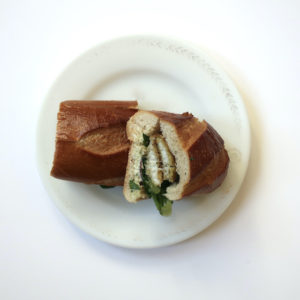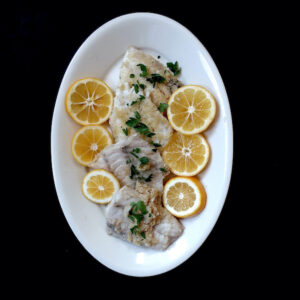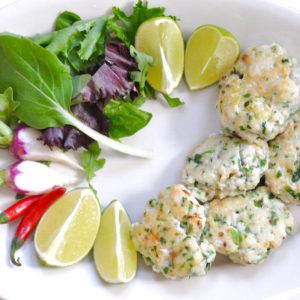Fancying up Fish
For years I avoided both cooking or eating fish, making exceptions for shellfish or sushi, and those only in restaurants. Then I acquired an extremely skinny, fish-loving boyfriend, only to go ahead and marry him.
Marriage meant better glassware, matching plates, and legal status. It did nothing for my piscatory issues. Fish cookery unnerved me in its precision: the moment between done and ruined seemed more like a flutter. When you’re newly married, in grad school, with two black kittens nosing adorably at your feet, who needs that kind of stress?
On the rare occasions I cooked fish that turned out, it came to the table tasting of mud. Or nothing at all. Why not roast a chicken? Open a can of beans? Throw up your hands and eat out?
Because you married a fish lover, that’s why. In lieu of finding a new mate, there was nothing to do but master fish cookery. Eating it was another matter.
Which brings us to cooking. Yes, fish requires attention. But if you can drive a car, operate a washing machine, or keep a domestic pet alive, you can cook fish. Note I do not say “cook lobster.” I’ve eaten lobster exactly once, in the revolving restaurant high above almost everything else in the CN Tower. This was literally in the last century, and it was all lobster should be, which includes prepared by somebody else. In these macho cooking days, we’re all supposed to be fearless, striding into our kitchens like Anthony Bourdain, who in the Les Halles Cookbook called lobsters “essentially big fucking bugs.” Maybe, but the idea of live lobsters in my kitchen leads to visions of Woody Allen and Diane Keaton shrieking while those big bugs with their big pincers run under the stove. I don’t care how dumb they are.
In an effort to meet John halfway, I learned to prepare frozen fish, then graduated to fresh fillets. While I’ve become a confident fish cook, I remain a picky eater with expensive tastes. Dungeness crab, anyone? Yellowtail sushi?
This recipe works with any thick whitefish fillet: this recipe used sable. Cod, Tilapia, and Catfish would also work
Kerrygold Butter is a high butterfat Irish butter; at about $3.00 a pound, it’s an inexpensive luxury. Even a small amount truly lifts the flavor of a bland fish.
Fancied-up Whitefish Fillet
serves 1-2
3/4 pound whitefish fillet, fresh or frozen, defrosted
2 1/2 teaspoons sea salt
juice 1/2 lemon
1 1/2 teaspoons unsalted butter, Kerrygold for preference
1/4 cup white wine or Vermouth
1 medium garlic clove, minced
1/2 teaspoon black pepper
Marinate the fish:
At least one hour and up to 8 hours before cooking, rinse and dry the fish fillet. Lay it in a tray or baking pan. Scatter the salt and squeeze the lemon juice over the fish. I often toss the used lemons in for a little extra zap. Cover and refrigerate until ready to cook.

To cook:
Heat a cast iron frying pan or heavy nonstick pan over medium heat. Melt the butter, adding the wine, garlic, and pepper. Lay the fish skin side down for 2 minutes. Flesh should be opaque. Using a fish slice or spatula, carefully turn the fish, giving it another 2 minutes.

Remove from heat. Fish should be opaque throughout; flesh should flake easily. Note that fish will continue cooking off heat.





